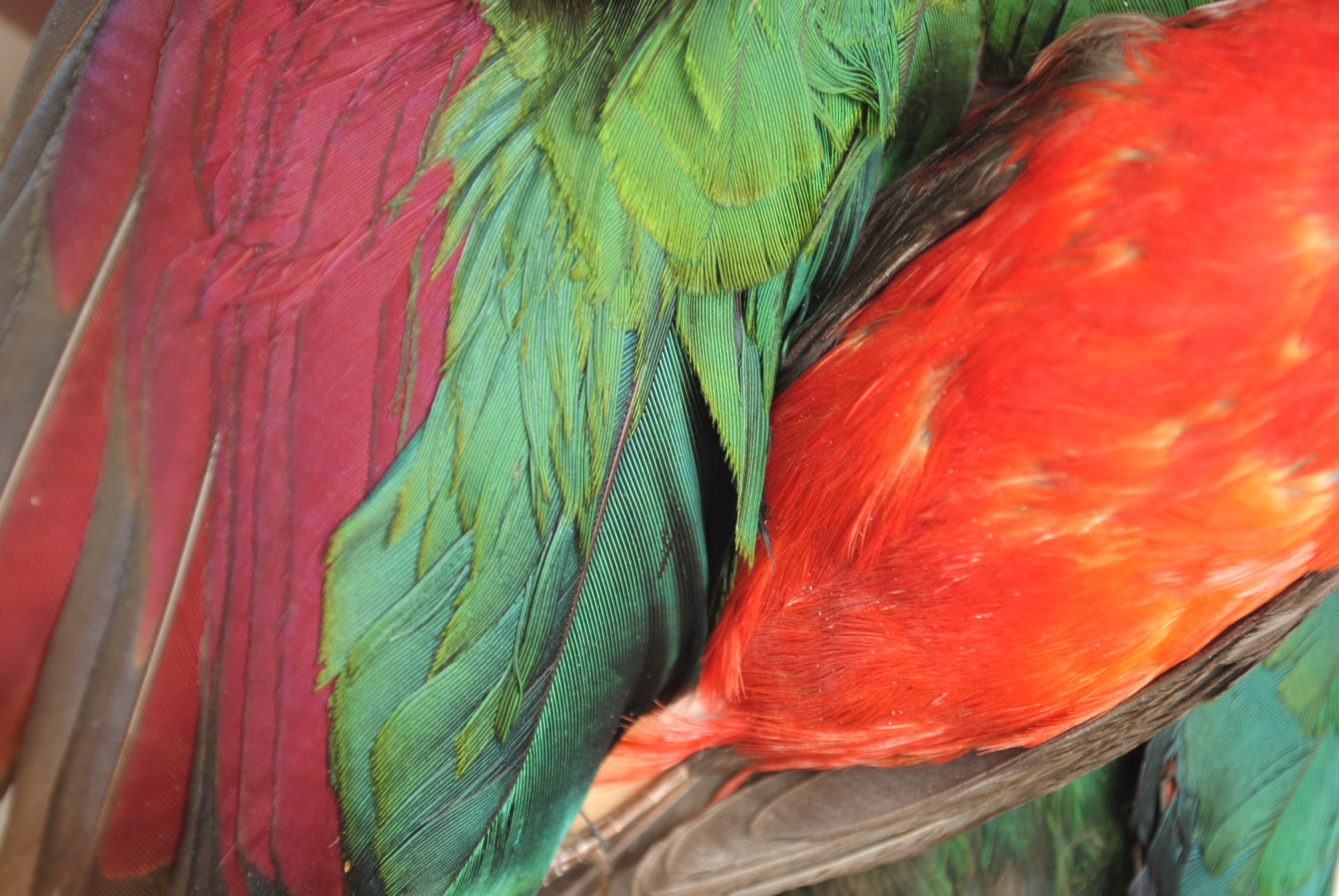|
Turacoverdin
Turacoverdin is a unique copper uroporphyrin pigment responsible for the bright green coloration of several birds of the family Musophagidae, most notably the turaco. It is chemically related to turacin, a red pigment also found almost exclusively in turacos. Turacoverdin is one of the only true green pigments found in birds, as the coloration that appears in most green feathers is due to the unique properties of blue structural coloration in combination with yellow carotenoids. Turacoverdin and turacin were the first ever chemically characterized feather pigments, and turacoverdin was first isolated and described in 1882 by Dr. C.F.W. Krukenberg. Chemical properties Few studies into the chemical nature of turacoverdin have been performed to date. Research by R.E. Moreau in the 1950s showed it to be less soluble in basic solutions than its chemical cousin turacin. While originally thought to contain little copper by its discoverer, who instead believed it to be iron-based, later ... [...More Info...] [...Related Items...] OR: [Wikipedia] [Google] [Baidu] |
Turacin
Turacin is a naturally occurring red pigment that is 6% copper complexed to uroporphyrin III. Arthur Herbert Church discovered turacin in 1869. It is found only in the bird family Musophagidae, the turacos. Other birds derive their red coloration from carotenoids (bright and orange-reds) or phaeomelanins (rusty and brownish-reds). It is often assumed that this coloration will wash out when the birds are bathing or after heavy rains, but this is true only if the water used for bathing happens to be very alkaline. See also * Psittacofulvin, a brightly colored red and yellow pigment unique to parrot Parrots, also known as psittacines (), are birds of the roughly 398 species in 92 genera comprising the order Psittaciformes (), found mostly in tropical and subtropical regions. The order is subdivided into three superfamilies: the Psittacoide ...s * Turacoverdin, green pigment unique to turacos References Biological pigments {{ornithology-stub ... [...More Info...] [...Related Items...] OR: [Wikipedia] [Google] [Baidu] |
Tauraco Persa32
''Tauraco'' is a genus of turacos. It contains the "typical" or green turacos; though their plumage is not always green all over, the presence of significant amounts of turacoverdin-colored plumage generally sets ''Tauraco'' species apart from other Musophagidae. Indeed, as opposed to any other known birds, ''Tauraco'' turacos are the only living bird taxa that have any significant green pigment whatsoever, as the greens of many parrots etc. are due to structural color, not pigment. Their genus name was derived from a native West African name. Taxonomy The genus ''Tauraco'' was introduced in 1779 by the Polish naturalist Jan Krzysztof Kluk. The type species was later designated as the Guinea turaco The Guinea turaco (''Tauraco persa''), also known as the green turaco or green lourie, is a species of turaco, a group of otidimorphae birds belonging to the family Musophagidae. It was formerly included in the Livingstone's, Schalow's, Knysn .... Species The genus contains 13 ... [...More Info...] [...Related Items...] OR: [Wikipedia] [Google] [Baidu] |
Chemical Polarity
In chemistry, polarity is a separation of electric charge leading to a molecule or its chemical groups having an electric dipole moment, with a negatively charged end and a positively charged end. Polar molecules must contain one or more polar bonds due to a difference in electronegativity between the bonded atoms. Molecules containing polar bonds have no molecular polarity if the bond dipoles cancel each other out by symmetry. Polar molecules interact through dipole–dipole intermolecular forces and hydrogen bonds. Polarity underlies a number of physical properties including surface tension, solubility, and melting and boiling points. Polarity of bonds Not all atoms attract electrons with the same force. The amount of "pull" an atom exerts on its electrons is called its electronegativity. Atoms with high electronegativitiessuch as fluorine, oxygen, and nitrogenexert a greater pull on electrons than atoms with lower electronegativities such as alkali metals and alkaline ... [...More Info...] [...Related Items...] OR: [Wikipedia] [Google] [Baidu] |
Galliformes
Galliformes is an order of heavy-bodied ground-feeding birds that includes turkeys, chickens, quail, and other landfowl. Gallinaceous birds, as they are called, are important in their ecosystems as seed dispersers and predators, and are often reared by humans for their meat and eggs, or hunted as game birds. The order contains about 290 species, inhabiting every continent except Antarctica, and divided into five families: Phasianidae (including chicken, quail, partridges, pheasants, turkeys, peafowl (peacocks) and grouse), Odontophoridae (New World quail), Numididae (guinea fowl), Cracidae (including chachalacas and curassows), and Megapodiidae (incubator birds like malleefowl and brush-turkeys). They adapt to most environments except for innermost deserts and perpetual ice. Many gallinaceous species are skilled runners and escape predators by running rather than flying. Males of most species are more colorful than the females, with often elaborate courtship behaviors t ... [...More Info...] [...Related Items...] OR: [Wikipedia] [Google] [Baidu] |
Crested Wood-partridge
The crested partridge (''Rollulus rouloul'') also known as the crested wood partridge, roul-roul, red-crowned wood partridge, green wood quail or green wood partridge is a gamebird in the pheasant family Phasianidae of the order Galliformes, gallinaceous birds. It is the only member of the genus ''Rollulus''. This small partridge is a resident breeder in lowland rainforests in south Burma, south Thailand, Malaysia, Sumatra and Borneo. Its nest is a ground scrape lined with leaves, which is concealed under a heap of leaf litter. Five or six white eggs are incubated for 18 days. Unusually for a galliform species, the young are fed bill-to-bill by both parents instead of pecking from the ground, and although precocial, they roost in the nest while small. The crested partridge is a rotund short-tailed bird, in length, with the male marginally larger than the female. Both sexes have a scarlet patch of bare skin around the eye and red legs without a spur or hind toe. The male ... [...More Info...] [...Related Items...] OR: [Wikipedia] [Google] [Baidu] |
Blood Pheasant
The blood pheasant (''Ithaginis cruentus''), also known as blood partridge, is the only species in genus ''Ithaginis'' of the pheasant family. It is a relatively small, short-tailed pheasant that is widespread and is fairly common in eastern Himalayas, ranging across India, Nepal, Bhutan, China, and northern Myanmar. Since the trend of the population appears to be slowly decreasing, the species has been evaluated as of least concern on the IUCN Red List in 2009. The blood pheasant was the national bird of the former Kingdom of Sikkim, and remains the state bird of Sikkim. Description The blood pheasant has the size of a small fowl, about in length with a short, convex, very strong black bill, feathered between bill and eye, and a small crest of variously coloured feathers. The colour of the plumage above is dark ash, with white shafts, the coverts of the wings various tinged with green, with broad strokes of white through the length of each feather, the feathers of the chi ... [...More Info...] [...Related Items...] OR: [Wikipedia] [Google] [Baidu] |
Northern Jacana
The northern jacana or northern jaçana (''Jacana spinosa'') is a wader which is known as a resident breeder from coastal Mexico to western Panama, and on Cuba, Jamaica and Hispaniola in the Caribbean. It sometimes known to breed in Texas, United States, and has also been recorded on several occasions as a vagrant in Arizona. The jacanas are a group of wetland birds, which are identifiable by their huge feet and claws, which enable them to walk on floating vegetation in the shallow lakes that are their preferred habitat. In Jamaica, this bird is also known as the 'Jesus bird', as it appears to walk on water. Jacana is Linnæus' scientific Latin spelling of the Brazilian Portuguese ''jaçanã,'' pronounced , from the Tupi name of the bird. See jacana for pronunciations. Description The northern jacana has a dark brown body with a black head and neck. In addition its bill has yellow patches and its forehead has a yellow wattle.Janzen, D.H., Ed. (1983). Costa Rican Natural Histo ... [...More Info...] [...Related Items...] OR: [Wikipedia] [Google] [Baidu] |
Spectrophotometry
Spectrophotometry is a branch of electromagnetic spectroscopy concerned with the quantitative measurement of the reflection or transmission properties of a material as a function of wavelength. Spectrophotometry uses photometers, known as spectrophotometers, that can measure the intensity of a light beam at different wavelengths. Although spectrophotometry is most commonly applied to ultraviolet, visible, and infrared radiation, modern spectrophotometers can interrogate wide swaths of the electromagnetic spectrum, including x-ray, ultraviolet, visible, infrared, and/or microwave wavelengths. Overview Spectrophotometry is a tool that hinges on the quantitative analysis of molecules depending on how much light is absorbed by colored compounds. Important features of spectrophotometers are spectral bandwidth (the range of colors it can transmit through the test sample), the percentage of sample-transmission, the logarithmic range of sample-absorption, and sometimes a percentage of ... [...More Info...] [...Related Items...] OR: [Wikipedia] [Google] [Baidu] |
Tauraco
''Tauraco'' is a genus of turacos. It contains the "typical" or green turacos; though their plumage is not always green all over, the presence of significant amounts of turacoverdin-colored plumage generally sets ''Tauraco'' species apart from other Musophagidae. Indeed, as opposed to any other known birds, ''Tauraco'' turacos are the only living bird taxa that have any significant green pigment whatsoever, as the greens of many parrots etc. are due to structural color, not pigment. Their genus name was derived from a native Niger–Congo languages, West African name. Taxonomy The genus ''Tauraco'' was introduced in 1779 by the Polish naturalist Jan Krzysztof Kluk. The type species was later designated as the Guinea turaco. Species The genus contains 13 species. References External links * * {{Taxonbar, from=Q654783 Tauraco, Bird genera ... [...More Info...] [...Related Items...] OR: [Wikipedia] [Google] [Baidu] |
Ultraviolet–visible Spectroscopy
UV spectroscopy or UV–visible spectrophotometry (UV–Vis or UV/Vis) refers to absorption spectroscopy or reflectance spectroscopy in part of the ultraviolet and the full, adjacent visible regions of the electromagnetic spectrum. Being relatively inexpensive and easily implemented, this methodology is widely used in diverse applied and fundamental applications. The only requirement is that the sample absorb in the UV-Vis region, i.e. be a chromophore. Absorption spectroscopy is complementary to fluorescence spectroscopy. Parameters of interest, besides the wavelength of measurement, are absorbance (A) or transmittance (%T) or reflectance (%R), and its change with time. Optical transitions Most molecules and ions absorb energy in the ultraviolet or visible range, i.e., they are chromophores. The absorbed photon excites an electron in the chromophore to higher energy molecular orbitals, giving rise to an excited state. For organic chromophores, four possible types of transitions ... [...More Info...] [...Related Items...] OR: [Wikipedia] [Google] [Baidu] |






.jpg)

